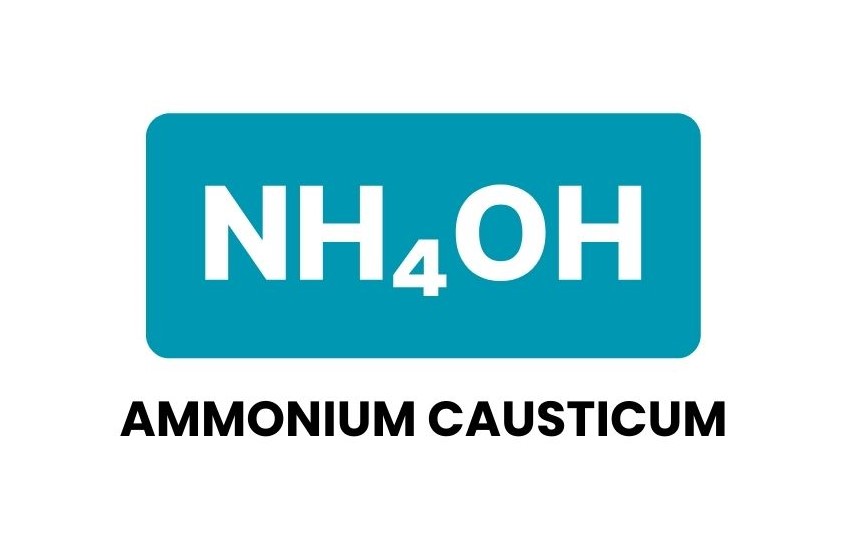Ammonium Causticum, known as Hydrate of Ammonia or Ammonia Water, is recognized for its potent cardiac stimulant properties.
It finds application in various conditions such as syncope, thrombosis, hemorrhages, snake-bites, and chloroform narcosis, where it can be administered through inhalation.
READ A DETAILED POST ON ALL ABOUT HOMOEOPATHIC MEDICINES AND WHAT ARE THE CARDINAL PRINCIPLES OF HOMOEOPATHY?

Table of Contents
ToggleSOURCE INFORATION
The term “Hydrate of Ammonia” typically refers to a solution of ammonia gas (NH3) dissolved in water. This solution is commonly known as “Ammonia Water.”
Ammonia itself is a compound consisting of one nitrogen atom and three hydrogen atoms.
In its gaseous form, it has a characteristic pungent odour.
Chemical Formula: NH₄OH (Hydrate of Ammonia)
Chemical Structure
- Nitrogen (N)
- Hydrogen (H)
Source Information
- Production: Ammonia is commonly produced through the Haber-Bosch process, which involves the synthesis of nitrogen and hydrogen gases under high pressure and temperature in the presence of a catalyst.
- Commercial Availability: Ammonia water, or the Hydrate of Ammonia, is available commercially and is commonly used in various industrial, household, and laboratory applications.
DRUG PHARMACOLOGY
- Cardiac Stimulation: Ammonium Causticum exhibits powerful cardiac stimulant properties, influencing heart function.
- Mucous Membrane Effects: The drug induces oedema and ulceration in mucous membranes, which becomes a key aspect of its therapeutic application.
CHIEF GUIDING SYMPTOMS
Cardiac Stimulant
- Ammonium Causticum acts as a powerful cardiac stimulant, making it beneficial in conditions like syncope, thrombosis, and hemorrhages.
Mucous Membrane Effects
- The oedema and ulceration of mucous membranes serve as guiding symptoms.
- It is particularly indicated in membranous croup with a burning sensation in the oesophagus, and aphonia.
Aphonia: Loss of Voice
Aphonia refers to the complete loss or significant impairment of the voice, rendering an individual unable to produce normal speech sounds. This condition is different from dysphonia, which involves disorders affecting the quality of the voice.
Causes
- Vocal Cord Disorders: Conditions affecting the vocal cords, such as nodules, polyps, or paralysis, can lead to aphonia.
- Infections: Infections of the throat or larynx, like laryngitis, can cause inflammation and affect vocal cord function.
- Neurological Issues: Damage or disorders of the nerves controlling the vocal cords may result in aphonia.
- Trauma: Injury to the larynx or vocal cords, often due to excessive strain on the voice, can lead to temporary or permanent loss of voice.
- Psychological Factors: Emotional stress or psychological factors may contribute to functional voice disorders.
Symptoms
- Complete loss of voice or significant hoarseness.
- Difficulty or pain while speaking.
- Changes in pitch or tone of the voice.
Respiratory System
- Difficulty in respiration, mucus accumulation with incessant coughing, loss of voice, and burning rawness in the throat are characteristic symptoms.
- There may be spasms of the glottis with suffocation, leading to the patient gasping for breath.
- Pain in the oesophagus during deep breathing and scraping and burning sensations in the throat and exophages are notable.
Extremities
- Excessive exhaustion and muscular debility are observed.
- Rheumatism affecting the shoulders may be present. The skin tends to be hot and dry.
RELATIONSHIP
- Aphonia: Ammonium Causticum’s use is related to Causticum, especially in cases of membranous croup.
DOSE
- Ammonium Causticum is typically administered in the first to the third potency.
- Additionally, it can be given in the form of five to ten minims, well diluted with water.
FREQUENTLY ASKED QUESTIONS
What is the primary application of Ammonium Causticum?
- Ammonium Causticum is primarily known for its potent cardiac stimulant properties and is indicated in conditions such as syncope, thrombosis, hemorrhages, snake-bites, and chloroform narcosis.
How does Ammonium Causticum affect mucous membranes?
- The drug induces oedema and ulceration in mucous membranes, which serves as a guiding symptom for its use.
- It is notably applied in conditions like membranous croup with a burning sensation in the oesophagus and aphonia.
What is the recommended dose of Ammonium Causticum?
- Ammonium Causticum is typically administered in the first to third potency.
- Alternatively, it can be given in the form of five to ten minims, well diluted with water.
In what conditions can Ammonium Causticum be inhaled?
- Ammonium Causticum may be inhaled in conditions such as syncope, thrombosis, hemorrhage, snake-bites, and chloroform narcosis for its beneficial effects.
